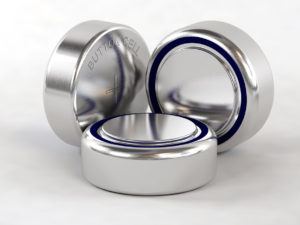Button Battery Dangers — Harming 3,500-Plus Annually

Button Battery Dangers
Christmas never will be the same for Texas woman Trista Hamsmith. One week before the most wonderful time of the year – Dec. 17, 2020 – Hamsmith’s 18-month-old daughter died a terrible death.
Reese, a blond, rosy-cheeked baby, swallowed a button battery, which the National Center for Biotechnology Information (NCBI) describes as “the most dangerous form of foreign body ingestion commonly encountered in pediatrics.” In an article titled “Button Battery Ingestion in Children,” the NCBI evaluated 13 cases that resulted in serious injuries and deaths to children and came to some harrowing conclusions.
“A multidisciplinary approach is needed to most effectively manage these patients, including emergency medicine, anesthesia, pediatric gastroenterology, pediatric surgery / cardiothoracic surgery, otolaryngology, interventional cardiology, and radiology,” according to the article. “Even after removal of the battery from the esophagus, there may be ongoing evolution of the injury for up to several weeks thereafter, placing patients at risk for a catastrophic aortoesophageal fistula or other severe sequelae.”
An aortoesophageal fistula is an rare complication, yet it almost always is lethal, especially in children who swallow button batteries.
“After battery removal, the scope should be reinserted into the esophagus and another careful examination of the mucosa performed to better assess the severity and location of any injury as well as to determine the most likely complications…,” according to the article. “The role of repeat endoscopy in the management of these patients is also ripe for debate. Although others have cited the value of a second-look endoscopy 2 to 4 days after ingestion to help determine the timing of feeding introduction…such timing for a second look may lead to false reassurance about continued risks for complications.”
The evolution of technology and the production of gadgets that do this, that and the other have made button batteries ubiquitous. The small, silver electrical devices power digital cameras, smart watches, key fobs, remote controls and more. Here is a list of items that use them:
- Musical greeting cards
- Talking books
- Games
- Toys
- Electric candles and tea lights
- Hearing aids
- Calculators
- Flashing clothes, jewelry and shoes
A button battery from the remote control is what Reese swallowed in October 2020. Around Halloween, Hamsmith noticed Reese showing signs of a common cold and took her to the pediatrician who unfortunately misdiagnosed the condition as croup. When Hamsmith finally realized a battery was missing from the remote control, she raced to the hospital for an X-ray that confirmed the dire news.
“When a button battery is swallowed, electrical current can form and create a chemical that burns through the body’s tissue – damage that may continue even after the battery is removed,” MSNBC reported in a story covering the tragedy. “The initial surgery went well, but doctors later found the battery had created a hole between Reese’s esophagus and trachea. After several brutal weeks of ups and downs, including Reese being placed on a ventilator and receiving a tracheotomy, the 18-month-old died on Dec. 17, 2020.
“Hamsmith and her family were shattered,” the story continued. “Yet her grief fueled her to take action almost immediately, creating a non-profit called Reese’s Purpose to advocate for legislation mandating secure, tool-required compartments for button batteries and to educate parents and physicians about the signs of ingestion.”
Reese’s Purpose is an advocacy organization taking a three-tiered approach to address the issue. One goal is to require all devices that use button batteries to have secure battery compartments. A second goal is to advocate for the research and development of safer button batteries. Third, the group aims to educate the public about the symptoms that arise after a child swallows a button battery.
“Our first and primary focus is to raise awareness of the dangers of button batteries and to advocate for legislative action to prevent other families from suffering – either with lifelong health issues or the death of a beloved child – due to accidental button battery ingestion,” the Reese’s Purpose Web site states.
The National Capital Poison Center says over 3,500 cases of ingesting button batteries occur every year in the United States – in children and adults. If a button battery is ingested, the National Battery Ingestion Hotline should be called at 800-498-8666. If possible, the battery identification number should be reported.
“In most cases, an x-ray must be obtained right away to be sure that the battery has gone through the esophagus into the stomach,” the National Capital Poison Center says. “Based on the age of the patient and size of the battery, the National Battery Ingestion Hotline specialists can help you determine if an immediate x-ray is required.”
Share This


